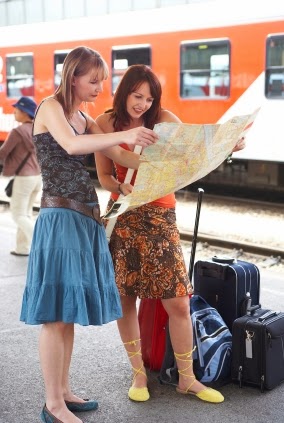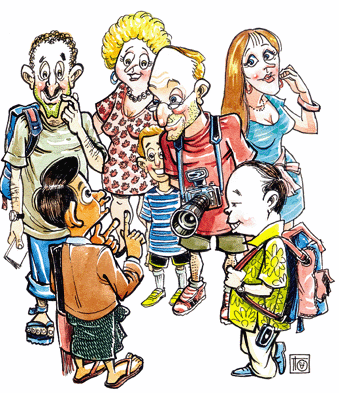Thai Dessert, Bananas In Coconut Milk
This
Thai banana dessert is made with bananas cooked in coconut milk and topped with
coconut cream. The bananas are the kluai nam wa variety and the word kluai means
banana. The Thai name of this banana dessert is kluai buat chi.
Popular Thai Banana
Dessert, Kluai Nam Wa Bananas In Coconut Milk
Called 'Kluai Buat Chi' In Thai
This banana dessert is fully vegetarian and is a very common Thai dessert. The main ingredient in the Thai banana dessert is a particular type of bananas and coconut milk. For good taste you will need to use the kluai nam wa type of bananas. The botanical name of these bananas is musa sapientum and the bananas are around 4 to 5 inches long. There is a similar banana dessert made in certain parts of India, but the Indian banana dessert uses milk (not coconut milk) and grated coconut. The bananas in the Indian dessert are the long sweet type of bananas and no cooking or heating is involved. In this section we discuss the Thai banana dessert recipe and provide some useful suggestions for enhancing it's taste.
Called 'Kluai Buat Chi' In Thai
This banana dessert is fully vegetarian and is a very common Thai dessert. The main ingredient in the Thai banana dessert is a particular type of bananas and coconut milk. For good taste you will need to use the kluai nam wa type of bananas. The botanical name of these bananas is musa sapientum and the bananas are around 4 to 5 inches long. There is a similar banana dessert made in certain parts of India, but the Indian banana dessert uses milk (not coconut milk) and grated coconut. The bananas in the Indian dessert are the long sweet type of bananas and no cooking or heating is involved. In this section we discuss the Thai banana dessert recipe and provide some useful suggestions for enhancing it's taste.
Ingredients
Ripe Nam Wa
type bananas
|
5 bananas
|
Coconut cream
|
1/4 Cup
|
Coconut milk
|
1.5 Cups
|
Sugar
|
1/2 Cup
|
Salt
|
1/2 Teaspoon
|
***Suitable for
4-5 persons***
Procedure
Preparing the bananas: Peel the bananas and slit vertically into
half, then once again cut the pieces horizontally into half. Each banana would
now be cut into four pieces and this is the ideal size for the bananas in the
dessert to get cooked well. Notice whether the bananas are soft (ripe enough)
or a little stiff as you cut them. This information will be needed as we
proceed further in the Thai banana dessert recipe.
Working with the
coconut milk: Pour the coconut
milk into a pot and turn on the heat. This is one of the main ingredients in
the banana dessert recipe and the coconut milk needs to boil before we proceed.
After the milk has started boiling, lower the heat to medium level and drop the
banana pieces into the boiling coconut milk. For the ideal banana dessert, the
bananas will have to cook until tender. It is not advisable to overcook the
bananas as this will make them very soft and bloated. Sufficiently riped
bananas will become tender sooner than bananas that are partially riped. Once
the bananas are tender turn off the heat. Now, add the sugar and salt into the
pot and keep stirring until they have dissolved.
Finishing and serving: Now add the coconut cream into the pot and
share the banana dessert into small bowls. Let the Thai dessert come to room
temperature and then serve. The bananas in the dessert should remain as
distinct pieces and not break down to a pulp. It is therefore important that
you do not overcook the bananas in the coconut milk. Some cooks prefer to
spread the coconut cream on the bananas after the dessert has been shared into
smaller bowls. This is a minor change to the banana dessert recipe and you
could try it out.
The kluai nam wa bananas
used in the Thai banana dessert recipe are around 4 to 5 inches long. The
botanical name for these bananas is musa sapientum. The recipe for this
Thai dessert needs to consider whether the bananas are quite raw or
sufficiently ripe.
Additional Tips
Making coconut cream
and coconut milk: If
coconut milk or coconut cream are not readily available, get some dried
coconut cream powder from the grocery store and prepare the coconut cream
and milk. Basically, you will need to add more water to the cream powder to get
coconut milk and add less water to get the required consistency for coconut
cream. The packet should provide instructions for this, but you can try this
yourself by first mixing a teaspoon of the coconut cream powder in water. You
will soon get to be very efficient in judging the amount of water required to
be added. Grocery stores also sell dried coconut called desiccated coconut.
This can also be used to prepare the coconut milk and cream required in the
Thai banana dessert recipe. First place around 500 grams of desiccated coconut
in a bowl, the bowl should be fairly large. Boil 3 cups of water and turn off
the heat when boiled, now pour the hot water on the desiccated coconut in the
bowl. Leave the bowl for around 15-20 minutes and after that, take a fine cloth
and strain the mixture of desiccated coconut and water through the cloth.
Squeeze as much as you can and use the extract as coconut cream. Now once again
add 3 cups of hot water into the same bowl with the (same) desiccated coconut,
leave still for 15-20 minutes and do another strain through the fine cloth.
This extract will be slightly thinner than the first one and can be used as the
coconut milk for our banana dessert recipe.
Checking the bananas: As mentioned above, the kluai nam wa variety of bananas are most suited for the bananas in coconut milk recipe. The normal long bananas do not have the required consistency and will disintegrate into a pulp when cooked. If the bananas are very ripe, you can reduce the amount of sugar to be added to the banana dessert. Also pay attention when boiling very ripe bananas in coconut milk, ripe bananas will become tender faster than bananas that are not fully riped. If you over boil the riped bananas, they will bloat and disintegrate while cooking. In case your bananas are not yet ripe, a slight change in the recipe for the Thai banana dessert will have to be made. These bananas will have a stickiness that needs to be taken away. Take a bowl of water with around 3 cups of water and boil the bananas in the bowl for around 3-5 minutes. Now take the bananas out of the bowl and keep them ready for the next step. Bananas that are not yet fully ripe would not be very sweet and this requires a small change in the banana dessert recipe. The only change that you will need to make is to add the sugar into the coconut milk and then boil the banana pieces in the coconut milk. This will spread the sweetness of the sugar right through the banana pieces and enhance the taste of the banana dessert. The rest of the banana dessert recipe will remain the same.
Thank you for watching my video^^
Checking the bananas: As mentioned above, the kluai nam wa variety of bananas are most suited for the bananas in coconut milk recipe. The normal long bananas do not have the required consistency and will disintegrate into a pulp when cooked. If the bananas are very ripe, you can reduce the amount of sugar to be added to the banana dessert. Also pay attention when boiling very ripe bananas in coconut milk, ripe bananas will become tender faster than bananas that are not fully riped. If you over boil the riped bananas, they will bloat and disintegrate while cooking. In case your bananas are not yet ripe, a slight change in the recipe for the Thai banana dessert will have to be made. These bananas will have a stickiness that needs to be taken away. Take a bowl of water with around 3 cups of water and boil the bananas in the bowl for around 3-5 minutes. Now take the bananas out of the bowl and keep them ready for the next step. Bananas that are not yet fully ripe would not be very sweet and this requires a small change in the banana dessert recipe. The only change that you will need to make is to add the sugar into the coconut milk and then boil the banana pieces in the coconut milk. This will spread the sweetness of the sugar right through the banana pieces and enhance the taste of the banana dessert. The rest of the banana dessert recipe will remain the same.
Let's see Easy way save time to cooking"Banana Desert in coconut milk"
Thank you for watching my video^^












































